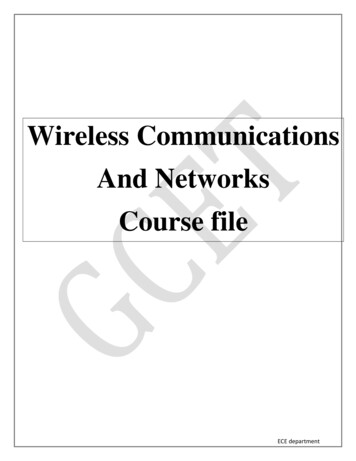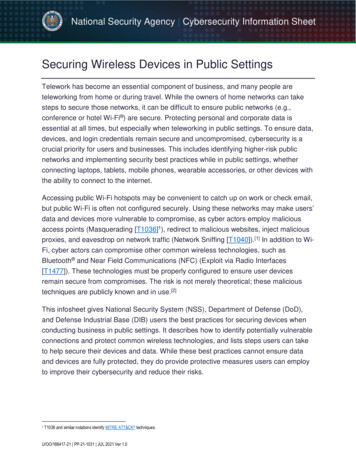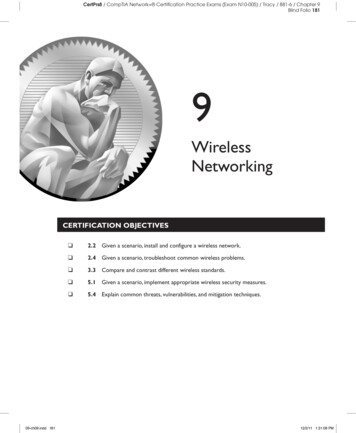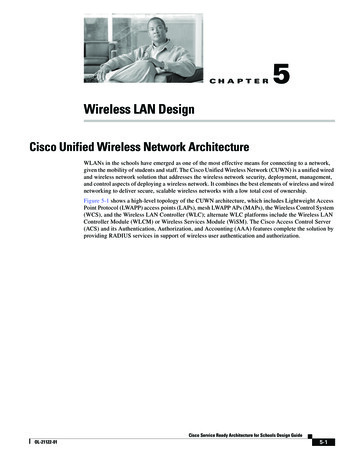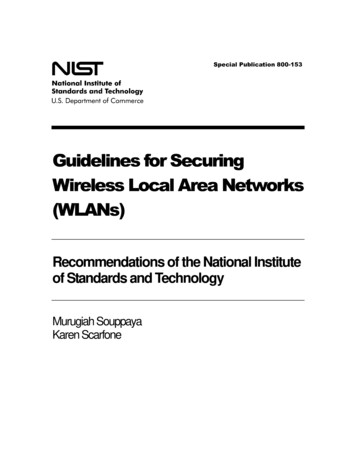
Transcription
Special Publication 800-153Guidelines for SecuringWireless Local Area Networks(WLANs)Recommendations of the National Instituteof Standards and TechnologyMurugiah SouppayaKaren Scarfone
NIST Special Publication 800-153Guidelines for Securing Wireless LocalArea Networks (WLANs)Recommendations of the NationalInstitute of Standards and TechnologyMurugiah SouppayaKaren ScarfoneC O M P U T E RS E C U R I T YComputer Security DivisionInformation Technology LaboratoryNational Institute of Standards and TechnologyGaithersburg, MD 20899-8930February 2012U.S. Department of CommerceJohn Bryson, SecretaryNational Institute of Standards and TechnologyPatrick D. Gallagher,Under Secretary for Standards and Technologyand Director
GUIDELINES FOR SECURING W IRELESS LOCAL AREA NETWORKS (WLANS)Reports on Computer Systems TechnologyThe Information Technology Laboratory (ITL) at the National Institute of Standards and Technology(NIST) promotes the U.S. economy and public welfare by providing technical leadership for the nation’smeasurement and standards infrastructure. ITL develops tests, test methods, reference data, proof ofconcept implementations, and technical analysis to advance the development and productive use ofinformation technology. ITL’s responsibilities include the development of technical, physical,administrative, and management standards and guidelines for the cost-effective security and privacy ofsensitive unclassified information in Federal computer systems. This Special Publication 800-seriesreports on ITL’s research, guidance, and outreach efforts in computer security and its collaborativeactivities with industry, government, and academic organizations.National Institute of Standards and Technology Special Publication 800-15324 pages (Feb. 2012)Certain commercial entities, equipment, or materials may be identified in thisdocument in order to describe an experimental procedure or concept adequately.Such identification is not intended to imply recommendation or endorsement by theNational Institute of Standards and Technology, nor is it intended to imply that theentities, materials, or equipment are necessarily the best available for the purpose.iii
GUIDELINES FOR SECURING W IRELESS LOCAL AREA NETWORKS (WLANS)AcknowledgmentsThe authors, Murugiah Souppaya of the National Institute of Standards and Technology (NIST) andKaren Scarfone of Scarfone Cybersecurity, wish to thank their colleagues who reviewed drafts of thisdocument and contributed to its technical content, particularly Sheila Frankel, Arnold Johnson, and TerryHahn of NIST, and representatives from the Department of Justice and the Office of the Director ofNational Intelligence.Trademark InformationAll trademarks and registered trademarks belong to their respective organizations.iv
GUIDELINES FOR SECURING W IRELESS LOCAL AREA NETWORKS (WLANS)Table of ContentsExecutive Summary .vi1.Introduction . 11.11.21.31.42.WLAN Security Configuration . 32.12.23.Authority . 1Purpose and Scope . 1Audience . 1Document Structure . 1Configuration Design . 42.1.1 Needs Gathering . 42.1.2 WLAN Architecture. 4Configuration Implementation, Evaluation, and Maintenance . 7WLAN Security Monitoring . 83.13.23.33.4WLAN Security Monitoring Basics . 83.1.1 Attack Monitoring . 93.1.2 Vulnerability Monitoring .10Monitoring Tools . 10Continuous Monitoring Recommendations . 11Periodic Assessment Recommendations. 12List of AppendicesAppendix A— Supporting NIST SP 800-53 Security Controls and Publications .13Appendix B— Acronyms and Abbreviations .16Appendix C— References .17List of FiguresFigure 1: Simplified View of WLAN Architecture . 3v
GUIDELINES FOR SECURING W IRELESS LOCAL AREA NETWORKS (WLANS)Executive SummaryA wireless local area network (WLAN) is a group of wireless networking devices within a limitedgeographic area, such as an office building, that exchange data through radio communications. WLANtechnologies are based on the IEEE 802.11 standard and its amendments.1 The fundamental componentsof an IEEE 802.11 WLAN (hereafter referred to as a “WLAN” in this publication) are client devices, suchas laptops and smartphones, and access points (APs), which logically connect client devices with adistribution system, typically the organization’s wired network infrastructure. Some WLANs also usewireless switches, which act as intermediaries between APs and the distribution system.The security of each WLAN is heavily dependent on how well each WLAN component—including clientdevices, APs, and wireless switches—is secured throughout the WLAN lifecycle, from initial WLANdesign and deployment through ongoing maintenance and monitoring. Unfortunately, WLANs aretypically less secure than their wired counterparts for several reasons, including the ease of access to theWLAN and the weak security configurations often used for WLANs (to favor convenience over security).The purpose of this publication is to help organizations improve their WLAN security by providingrecommendations for WLAN security configuration and monitoring. This publication supplements otherNIST publications by consolidating and strengthening their key recommendations.Organizations should implement the following guidelines to improve the security of their WLANs.Have standardized security configurations for common WLAN components, such as client devicesand APs.A standardized configuration provides a base level of security, reducing vulnerabilities and lessening theimpact of successful attacks. Standardized configurations can also significantly reduce the time and effortneeded to secure WLAN components and verify their security, particularly if the configuration can bedeployed and verified through automated means.When planning WLAN security, consider the security not only of the WLAN itself, but also how itmay affect the security of other networks.A WLAN is usually connected to an organization’s wired networks, and WLANs may also be connectedto each other. For WLANs that need wired network access, their client devices should be allowed accessonly to the necessary hosts on the wired network using only the required protocols. Also, an organizationshould have separate WLANs if there is more than one security profile for WLAN usage; for example, anorganization should have logically separated WLANs for external use (such as guests) and internal use.Devices on one WLAN should not be able to connect to devices on a logically separated WLAN.Have policies that clearly state which forms of dual connections are permitted or prohibited forWLAN client devices, and enforce these policies through the appropriate security controls.The term “dual connected” generally refers to a client device that is connected to both a wired networkand a WLAN at the same time. If an attacker gains unauthorized wireless access to a dual-connectedclient device, the attacker could then use it to access or attack resources on the wired network.Organizations should consider the risks posed not only by the traditional form of dual connectness, butalso by other forms involving multiple wireless networks. It is common today for client devices to beconnected to multiple wireless networks simultaneously, such as cell phone, WiMAX, Bluetooth, andWLAN networks. Organizations should assess the risk of the possible combinations of network1See [GAO-11-43] for additional information on the history of the IEEE 802.11 standard for WLANs.vi
GUIDELINES FOR SECURING W IRELESS LOCAL AREA NETWORKS (WLANS)technologies for their WLAN client devices and determine how those risks should be mitigated. If one ormore of the networks cannot have its risk mitigated to an acceptable level, then dual connectionsinvolving that network may pose too much risk to the organization and may need to be prohibited.Ensure that the organization’s WLAN client devices and APs have configurations at all times thatare compliant with the organization’s WLAN policies.After designing WLAN security configurations for client devices and APs, an organization shoulddetermine how the configurations will be implemented, evaluate the effectiveness of the implementations,deploy the implementations to the appropriate devices, and maintain the configurations and theirimplementations throughout the devices’ lifecycles. Organizations should standardize, automate, andcentralize as much of their WLAN security configuration implementation and maintenance as practical.This allows organizations to implement consistent WLAN security throughout the enterprise, to detectand correct unauthorized changes to configurations, and to react quickly when newly identifiedvulnerabilities or recent incidents indicate a need to change the WLAN’s security configuration.Perform both attack monitoring and vulnerability monitoring to support WLAN security.Security monitoring is important for all systems and networks, but it is generally even more important forWLANs because of the increased risks that they face. Organizations should continuously monitor theirWLANs for both WLAN-specific and general (wired network) attacks. Organizations should do largelythe same vulnerability monitoring for WLAN components that they do for any other software: identifyingpatches and applying them, and verifying security configuration settings and adjusting them as needed.These actions should be performed at least as often for WLAN components as they are for theorganization’s equivalent wired systems.Conduct regular periodic technical security assessments for the organization’s WLANs.These assessments should be performed at least annually to evaluate the overall security of the WLAN. Inaddition, organizations should perform periodic assessments at least quarterly unless continuousmonitoring of WLAN security is already collecting all of the necessary information about WLAN attacksand vulnerabilities needed for assessment purposes.vii
GUIDELINES FOR SECURING W IRELESS LOCAL AREA NETWORKS (WLANS)1.Introduction1.1AuthorityThe National Institute of Standards and Technology (NIST) developed this document in furtherance of itsstatutory responsibilities under the Federal Information Security Management Act (FISMA) of 2002,Public Law 107-347.NIST is responsible for developing standards and guidelines, including minimum requirements, forproviding adequate information security for all agency operations and assets; but such standards andguidelines shall not apply to national security systems. This guideline is consistent with the requirementsof the Office of Management and Budget (OMB) Circular A-130, Section 8b(3), “Securing AgencyInformation Systems,” as analyzed in A-130, Appendix IV: Analysis of Key Sections. Supplementalinformation is provided in A-130, Appendix III.This guideline has been prepared for use by Federal agencies. It may be used by nongovernmentalorganizations on a voluntary basis and is not subject to copyright, though attribution is desired.Nothing in this document should be taken to contradict standards and guidelines made mandatory andbinding on Federal agencies by the Secretary of Commerce under statutory authority, nor should theseguidelines be interpreted as altering or superseding the existing authorities of the Secretary of Commerce,Director of the OMB, or any other Federal official.1.2Purpose and ScopeThe purpose of this publication is to provide organizations with recommendations for improving thesecurity configuration and monitoring of their IEEE 802.11 wireless local area networks (WLANs) andtheir devices connecting to those networks. The scope of this publication is limited to unclassifiedwireless networks and unclassified facilities within range of unclassified wireless networks.This publication supplements other NIST publications by consolidating and strengthening their keyrecommendations, and it points readers to the appropriate NIST publications for additional information(see Appendix C for the full list of references and Appendix A for a list of major security controlsrelevant for WLAN security). This publication does not eliminate the need to follow recommendations inother NIST publications, such as [SP800-48] and [SP800-97]. If there is a conflict betweenrecommendations in this publication and another NIST wireless publication, the recommendation in thispublication takes precedence.1.3AudienceThe primary audience for this publication is security professionals, network professionals, systemadministrators, and others who are responsible for planning, implementing, maintaining, and monitoringthe security of their organization’s WLANs and the devices that connect to those WLANs.1.4Document StructureThe remainder of this document is composed of the following sections and appendices: Section 2 provides recommendations for WLAN security configuration, including configurationdesign, implementation, evaluation, and maintenance.1
GUIDELINES FOR SECURING W IRELESS LOCAL AREA NETWORKS (WLANS) Section 3 presents an overview of WLAN security monitoring and gives relatedrecommendations, including criteria for selecting monitoring tools and guidelines for determininghow often to perform monitoring. Appendix A lists the major controls from NIST Special Publication 800-53, RecommendedSecurity Controls for Federal Information Systems and Organizations that affect WLAN security. Appendix B provides a list of acronyms and abbreviations used in this document. Appendix C lists references for this document.2
GUIDELINES FOR SECURING W IRELESS LOCAL AREA NETWORKS (WLANS)2.WLAN Security ConfigurationWireless networking enables computing devices with wireless capabilities to use computing resourceswithout being physically connected to a network. The devices simply need to be within a certain distance(known as the range) of the wireless network infrastructure. Wireless local area networks (WLANs) aregroups of wireless networking devices within a limited geographic area, such as an office building, thatare capable of exchanging data through radio communications. WLANs are usually implemented asextensions to existing wired local area networks (LANs) to provide enhanced user mobility and networkaccess. WLAN technologies are based on the IEEE 802.11 standard and its amendments. Throughout therest of this publication, the generic term “WLAN” refers to an IEEE 802.11 WLAN.The two fundamental types of WLAN components are client devices (such as laptops and smartphones)and access points (APs), which logically connect client devices with a distribution system (DS), typicallythe organization’s wired network infrastructure. The DS is the means by which client devices cancommunicate with the organization’s wired LANs and external networks such as the Internet. SomeWLANs also use wireless switches, which act as intermediaries between APs and the DS. The purpose ofthe switch is to assist administrators in managing the WLAN infrastructure. Figure 1 shows a simplifiedview of WLAN components that includes a wireless switch. WLANs without wireless switches have asimilar architecture, except that the APs connect directly to the DS.APWirelessSwitchAPDSAPFigure 1: Simplified View of WLAN ArchitectureThe security of each of the WLAN components—including client devices, APs, and wireless switches—isheavily dependent on their WLAN security configuration. This section explains why having standardizedsecurity configurations is important for WLAN components and provides recommendations fordesigning, implementing, evaluating, and maintaining those configurations, particularly for client devices.3
GUIDELINES FOR SECURING W IRELESS LOCAL AREA NETWORKS (WLANS)As explained in Section 1.2, the recommendations presented in this section supplement those provided forspecific WLAN technologies by other NIST publications [SP800-48, SP800-97].This section does not provide an exhaustive explanation of the entire security configuration lifecycle;rather, it highlights a few topics of particular relevance to WLAN security. Section 2.1 discusses securityconfiguration design, while Section 2.2 focuses on security configuration implementation, evaluation, andmaintenance.2.1Configuration DesignOrganizations should have standardized security configurations for their common WLAN components,such as client devices and APs. A standardized configuration provides a base level of security, reducingvulnerabilities and lessening the impact of successful attacks. Standardized configuration use improvesthe consistency and predictability of security, in conjunction with user training and awareness activitiesand other supporting security controls. Standardized configurations can also provide a large resourcesavings by reducing the time needed to secure each WLAN device and to verify its configuration forsecurity assessments, audits, etc., particularly if the configuration can be deployed and verified throughautomated means.This section focuses on two noteworthy aspects of configuration design: gathering needs and designingWLAN architectures.2.1.1Needs GatheringBefore designing a WLAN security architecture or WLAN component security configurations, anorganization should gather information on needs, particularly operational and security related ones. Thisshould include identifying relevant WLAN security requirements from applicable laws, policies,regulations, etc. For Federal agencies, this often includes requirements from OMB, the GovernmentAccountability Office (GAO), the Department of Homeland Security (DHS), and other agencies. Anotherpart of needs gathering is identifying and reviewing recommended WLAN security practices from Federalagencies (e.g., NIST Special Publications, DISA Security Technical Implementation Guides), WLANvendors, and other parties [NCP]. See Section 9 of [SP800-94] for examples of possible requirements toinclude in needs gathering.In addition to identifying these requirements and recommendations, organizations should also determinewhat threats their WLAN security faces. Organizations should conduct risk assessments to identify thethreats against their WLANs and determine the effectiveness of existing security controls in counteractingthe threats; they then should perform risk mitigation to decide what additional measures (if any) should beimplemented, as discussed in [SP800-37]. Performing risk assessments and mitigation helps organizationsdecide how their WLANs should be secured. See Section 3.1 for an overview of common WLAN threats.2.1.2WLAN ArchitectureWhen planning WLAN security, configuration designers should consider the security not only of theWLAN itself, but also how it may affect other networks that are accessible through it, such as internalwired networks reachable from the WLAN. An important principle of WLAN security is to separateWLANs with different security profiles. For example, there should be separate WLANs for external(guest, etc.) and internal use. Devices on an organization’s external WLAN should not be able to connectthrough that WLAN to devices on another of the organization’s WLANs. This helps to protect theorganization’s other networks and devices from external devices and users. Organizations often set upexternal WLANs primarily to provide Internet access to visitors; such WLANs should be architected so4
GUIDELINES FOR SECURING W IRELESS LOCAL AREA NETWORKS (WLANS)that their traffic does not traverse the organization’s internal networks. For external WLANs that do needinternal network access, WLAN client devices should be allowed access only to the necessary hosts orsubnets using only the required protocols.Another architectural issue mentioned in the WLAN reference architecture document and discussed inmore detail in [GAO-11-43] is dual connected client devices. The term “dual connected” generally refersto a device that is connected to both a wired network and a WLAN at the same time. The primary concernwith dual connected configurations is that an attacker may be able to gain unauthorized wireless access tothe client device and then use it to attack resources on the wired network. Essentially this is allowing anattacker to exploit a lower-security network in order to gain access to a higher-security network. Onepossible scenario is an attacker tunneling traffic from the higher-security network to the lower-securitynetwork through the client device instead of following the intended network architecture, and thusavoiding network-based security controls intended for the higher-security network. Dual connectedconfigurations also generally violate the principle of disabling unneeded network services to reduce attacksurface; if the device is already connected to a wired network access, WLAN access is usually redundant.Organizations should not only consider simultaneous wired network and WLAN use, but other forms ofdual connectedness involving their WLAN client devices. With the increasing variety and popularity ofwireless networking technologies, it is common today for devices to be connected to multiple wirelessnetworks simultaneously. For example, most smartphones can use cell phone networks, WLANs, andBluetooth networks simultaneously, while they are also connected to wired laptops/desktops (andpossibly their wired networks) through a cabled connection (e.g., USB). It is also increasingly commonfor laptops to have multiple wireless interfaces, such as both WLAN and WiMAX interfaces, or to beconfigured to accept removable media-based WLAN interfaces. A single laptop with multiple WLANinterfaces could have simultaneous connections to multiple WLANs, such as an organization WLAN andan external WLAN.Organizations should assess the risk of the possible combinations of network technologies for theirWLAN client devices and determine how those risks should be mitigated. This does not mean that allforms of dual connectedness should automatically be prohibited; examples of use cases that are oftenpermitted include a smartphone attaching to both a WLAN and a Bluetooth-networked earbudsimultaneously, and a laptop attaching to both a WLAN and a Bluetooth-networked keyboard and mousesimultaneously. However, the security of such use cases is largely dependent on the security of all of thenetworks. If one or more of the networks cannot have its risk mitigated to an acceptable level, then dualconnections involving that network may pose too much risk to the organization and may need to beprohibited. The primary risk-related issue to be considered is the likelihood of an attacker accessing andmanipulating legitimate communications and the possible and typical impact of such an attack.Organizations should have policies that clearly state which forms of dual connections are permitted orprohibited for their WLAN client devices under various circumstances. Organizations should enforcethese policies through the appropriate security controls, including the actions listed below: For all their WLAN client devices: disable all network interfaces that are not authorized for anyuse (including during contingency plans for business continuity, disaster recovery, etc.), andconfigure the device so that the user cannot enable them or otherwise circumvent the restrictions. For all their WLAN client devices not authorized for dual connections:oImplement the appropriate technical security controls (discussed below the bullets) so that alldual connected configurations are prohibited.5
GUIDELINES FOR SECURING W IRELESS LOCAL AREA NETWORKS (WLANS)o If feasible, configure the devices to disable bridging (passing traffic between the networks).This is precautionary in case an unauthorized dual connection occurs.For all their WLAN client devices authorized for dual connections:oImplement the appropriate technical security controls (discussed below the bullets) so that theauthorized dual connected configurations are only active when necessary and that all otherdual connected configurations are prohibited.oConfigure the devices to disable bridging (passing traffic between the networks) unlessabsolutely necessary.There are several options for implementing WLAN client device dual connection policies, such asprohibiting unauthorized configurations from being used and disabling authorized dual connections whennot needed. To enforce such restrictions, organizations should rely on automated technical controlswhenever feasible. Non-technical controls are usually not effective enough; for example, it is generallynot feasible to rely on users to remember to always promptly disable WLAN interfaces every time theyare no longer needed. Each organization should evaluate the possible controls for implementing dualconnection policies on their WLAN client devices and then choose the combinations of controls that aremost appropriate, providing sufficient security while also permitting necessary functionality.Some of the possible controls are preventative (implementing and enforcing a configuration), while othersare detective (monitoring a configuration, monitoring network activity, alerting when a problem isdetected, etc.) Preventative controls are generally preferable to detective controls, but it is even strongerto use both preventative and detective controls together. See Section 3 for more information onmonitoring (detective) controls.Preventative controls may need to enforce granular policies. For example, an organization might permitonly wired network usage while at their headquarters, but might permit wired or wireless access toexternal networks. Preventative controls may also need to provide flexibility; organizations often need toallow users to attach the organization’s mobile client devices to new external WLANs, and thus the usersneed some ability to manage their devices’ WLAN configuration.Examples of preventative controls include the following: Configure the device’s BIOS so that WLAN connections are automatically terminated when awired connection is detected. The BIOS setting for this is often called LAN/WLAN switching. Enable specialized software-based controls that permit either WLAN or wired network access,but not both simultaneously. These controls could be built into the operating system (OS),provided as part of the WLAN driver or management software, provided by the devicemanufacturer (e.g., laptop vendor), or acquired from third parties. These controls typically favorwired connections over WLAN because of their relative reliability, performance, and security. Configure host-based network security tools (e.g., host-based firewalls, host-based intrusiondetection and prevention systems) to prevent multiple network interfaces from being used at onetime. Specify and enforce authorized network profiles and/or unauthorized profiles through OS/domaincontrols, third party policy-based software, etc.6
GUIDELINES FOR SECURING W IRELESS LOCAL AREA NETWORKS (WLANS)There are other technical WLAN security controls, such as configuring clients so that they will notautomatically connect to any WLANs they detect, that are beneficial for WLAN security but not robustenough to prevent dual connections.2.2Configuration Implementation, Evaluation, and MaintenanceAfter designing a WLAN security configuration, an organization should determine how the configurationwill be implemented, evaluate the effectiveness of the implementation, deploy the implementation to theappropriate devices, and maintain the configuration and its implementation throughout the devices’lifecycles. Organizations should ensure that their WLAN client devices and APs have configurations at alltimes that are compliant with the organization’s WLAN policies.Organizations should standardize, automate, and centralize as much of their WLAN securityconfiguration implementation and maintenance as practical, particularly for their WLAN client devicesand access points. This allows organizations to implement consistent WLAN security throughout theenterprise, to detect and correct unauthorized changes to configurations, and to react quickly when newlyidentified vulnerabilities or recent incidents indicate a need to change the WLAN’s security configuration.Organizations can often leverage existing con
GUIDELINES FOR SECURING WIRELESS LOCAL AREA NETWORKS (WLANS) vi Executive Summary A wireless local area network (WLAN) is a group of wireless networking devices within a limited geographic area, such as an office building, that exchange data through radio communications. WLAN tec





